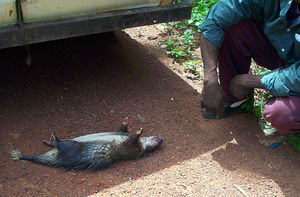African Brush-tailed Porcupine
2007 Schools Wikipedia Selection. Related subjects: Mammals
| iAfrican Brush-tailed Porcupine | ||||||||||||||||
|---|---|---|---|---|---|---|---|---|---|---|---|---|---|---|---|---|
 African brush-tailed porcupine sold for meat in Cameroon
|
||||||||||||||||
|
|
||||||||||||||||
 Least Concern (LC) |
||||||||||||||||
| Scientific classification | ||||||||||||||||
|
||||||||||||||||
|
|
||||||||||||||||
| Atherurus africanus (Gray, 1842) |
The African Brush-Tailed Porcupine (Atherurus africanus) is a species of rat-like Old World porcupine called " brush-tailed porcupines". The brush-tailed porcupines live in forests, usually at high elevations. They are nocturnal and during the day they sleep in caves and burrows. The brush-tailed porcupine is one of the biggest rodents in Africa, growing almost three feet long and weigh as much as eight pounds. It has an elongated rat-like face and body and short legs, tipped with clawed and webbed feet. Unlike most other porcupines, the brush-tailed porcupine has lighter and smaller quills. On the tail, these quills are thinner and brush-like. These can make noise when rattled. Brush-tailed porcupines live in small family groups of about eight members. Different family groups can share resources. When attacked by a predator, the porcupine raises its quills so it looks twice its size, rattles its tail quills, and stomps its feet. As with all porcupines, the brush-tailed porcupine would back into the attacker and inflict damage with its quills.
The brush-tailed porcupine is mostly herbivorous. When alone eating, the porcupines can be quite nervous. During the breeding season, males and females form pair bonds (just like how people go on dates) to get acquainted. The African brush-tailed porcupine has a long pregnancy compared to other rodents: 110 days at the longest. The young are born well-developed or precocial. Porcupines reach maturity at two years of age.
The meat of the African Brush-tailed Porcupine is very popular and is consumed in large quantities.